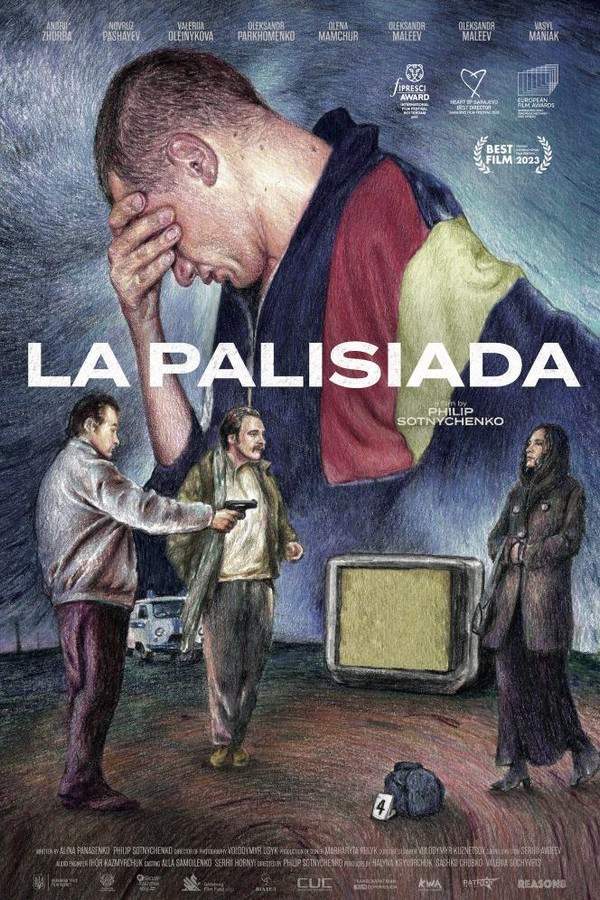La Palisiada 2024

Set in Ukraine in 1996, just five months before the moratorium on capital punishment, a police detective and a forensic psychiatrist, longtime friends, are drawn into an investigation of their colleague's murder. The case resurfaces old connections and long-buried feelings, particularly concerning the widow of the deceased, with whom both men were once in love. As they delve deeper into the investigation, they confront not only the present mystery but also the weight of their own unrealized ambitions and the legacy they will leave for their children.
Does La Palisiada have end credit scenes?
No!
La Palisiada does not have end credit scenes. You can leave when the credits roll.
Meet the Full Cast and Actors of La Palisiada
Explore the complete cast of La Palisiada, including both lead and supporting actors. Learn who plays each character, discover their past roles and achievements, and find out what makes this ensemble cast stand out in the world of film and television.
External Links and Streaming Options
Discover where to watch La Palisiada online, including streaming platforms, rental options, and official sources. Compare reviews, ratings, and in-depth movie information across sites like IMDb, TMDb, Wikipedia or Rotten Tomatoes.
Ratings and Reviews for La Palisiada
See how La Palisiada is rated across major platforms like IMDb, Metacritic, and TMDb. Compare audience scores and critic reviews to understand where La Palisiada stands among top-rated movies in its genre.

6.2 /10
IMDb Rating

3.3
From 11 fan ratings
Take the Ultimate La Palisiada Movie Quiz
Challenge your knowledge of La Palisiada with this fun and interactive movie quiz. Test yourself on key plot points, iconic characters, hidden details, and memorable moments to see how well you really know the film.
La Palisiada Quiz: Test your knowledge on the Ukrainian film 'La Palisiada' which explores the complexities of the death penalty and the investigation of a policeman's murder.
What profession does the main character Oleksandr have?
Full Plot Summary and Ending Explained for La Palisiada
Read the complete plot summary of La Palisiada, including all major events, twists, and the full ending explained in detail. Explore key characters, themes, hidden meanings, and everything you need to understand the story from beginning to end.
A forensic psychiatrist finds himself entangled in a complex web of intrigue when he becomes involved in the investigation surrounding the murder of a policeman, just a few months prior to the signing of Protocol No. 6 of the European Convention on Human Rights, which proposed the abolition of the death penalty. This is a groundbreaking Ukrainian film that delves into the controversial topic of capital punishment, a practice that lingered in the country for several years following its independence.
The story is partly inspired by the personal account of Philip Sotnychenko, who, at the tender age of seven, was struck by the harsh reality of executions occurring within his vicinity in Lukyanivka, specifically at the pre-trial detention center. This personal connection highlights deep-rooted societal issues regarding justice and morality in modern Ukraine.
The narrative unfolds through two intertwining timelines: the contemporary (the film’s beginning) and the gritty world of the 1990s, which forms the narrative’s core. Central to this intricate tale is forensic psychiatrist Oleksandr Mavrits, whose once-tranquil life is thrown into turmoil as he partners with investigator Sergiy Luzanovsky in the pursuit of justice for their slain colleague. Their investigation is not merely a matter of law enforcement; it becomes a matter of honor amongst friends who are also burdened with feelings for the deceased’s widow.
The film opens with a seemingly unrelated sequence focusing on contemporary hipsters and their trivial issues—however, this quickly transitions into a gripping investigation set in Uzhhorod in 1996. This initial backdrop can be interpreted from various angles: as a flashback, flashforward, or as a parallel narrative. The structure is intentionally disorienting; viewers may expect a traditional detective story typical of the 1990s, but are instead presented with a layered narrative that challenges traditional storytelling conventions.
As the film progresses, it is revealed that the plot’s second act serves not just as a flashback but is so intricately woven that it casts the initial scenes in a new light, forcing the audience to reconsider their perceptions. This isn’t a straightforward investigation, but rather a murky tale where two law enforcement officials wrestle with the integrity of their work as they attempt to fabricate a case against a suspect—pressured by a system eager to deliver swift justice before the death penalty becomes a relic of the past.
Within this ambiguous atmosphere, the essence of what the director refers to as “post-Soviet noir” or “neo-noir” is perfectly encapsulated. The depiction of the 1990s reveals a tumultuous era characterized by chaos and moral decay; it was a time when the nation was finding its footing amidst rampant corruption where various factions indulged in political maneuvering, privatization of public assets, and violent purges of competition. The counter-narratives emerge, leaving the audience questioning the identities of heroes and villains in this morally complex landscape.
Ultimately, the film employs a non-linear narrative that mirrors the intricate and cyclical nature of the stories it tells, much like a Möbius strip—seamlessly blending themes of justice, friendship, and the haunting repercussions of a turbulent past.
Watch Trailers, Clips & Behind-the-Scenes for La Palisiada
Watch official trailers, exclusive clips, cast interviews, and behind-the-scenes footage from La Palisiada. Dive deeper into the making of the film, its standout moments, and key production insights.
Movie Themes and Keywords
Discover the central themes, ideas, and keywords that define the movie’s story, tone, and message. Analyze the film’s deeper meanings, genre influences, and recurring concepts.
Quick Links: Summary, Cast, Ratings, More

What's After the Movie?
Not sure whether to stay after the credits? Find out!
Explore Our Movie Platform
New Movie Releases (2025)
Famous Movie Actors
Top Film Production Studios
Movie Plot Summaries & Endings
Major Movie Awards & Winners
Best Concert Films & Music Documentaries
© 2025 What's After the Movie. All rights reserved.














